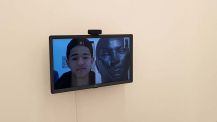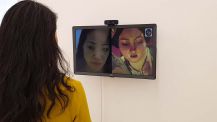Interactive Installation
Tate AI is an interactive installation. Visitors can observe how an AI bot reads their face, what it recognises and what it does not. From the online archive of the Tate Collection (tate-images.com), artworks are scanned for faces and compared with the face of the exhibition visitor. The visitor is immediately confronted with the image that most resembles him or her. Using Convolutional Neural Networks model and Dlib Machine Learning Face Recognition software.
Humanism in the continuous progress of the iteration of the technology environment always has its role, and technology between or in parallel, or intertwined. We should not consider so-called “humanism” and “technology” in isolation, rather we should consider the two as two roles of coexistence and balance in a larger dynamic historical continuum. However, we currently seem to be in a special historical stage, in this stage, the relevant technical acceleration and the singularity of the discussion forcing “humanism” and “technology” both constantly the shock of the new boundary and dynamic balancing. Therefore, in order not to get lost or fall into the binary dilemma, we need to knock to ask humanism: Can we follow a certain hint as in the past, or does a radical change take place immediately?
Software
Python, Linux, Dlib Machine Learning Face Recognition Software, Convolutional Neural Networks Model
Hardware
Flat screen 24 – 34 inch, webcam, Mac mini
Keywords
face recognition, convolutional neural networks, artificial intelligence, machine learning, speculative, simulation, interactive, installation, art archive, Tate Collection
Credits
Marc Lee and plotti
Dr. Ebermann (plotti) is a German senior data scientist working and living in Switzerland. He consults big advertising agencies and media conglomerates. He uses his machine learning expertise and his professional background to explore the intersection of artificial intelligence, art and activism.





